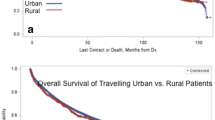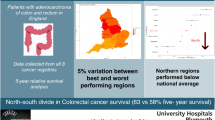Abstract
Many studies in clinical oncology rely on hospital-derived patients. Hospitals vary in the proportions of patients from the local catchment area vs.those from more distant places, of whom a larger proportion are presumably referrals. To study the differences between these two types of patients, we analyzed 1,245 colorectal cancer patients seen at a large urban medical center over a seven-year period. Three hundred ninety-eight patients were from the local community (32 percent), 489 were from the extended community (39.3 percent), and 358 from more distant communities (28.8 percent). The patients from the local community tended to be older and from minority ethnic groups. In addition, the local community patients were more likely to have advanced disease at the time of presentation. The grade of the tumor and its site distribution within the large bowel were similar for the three groups. After adjusting for age, sex, race, and stage of disease, the survival was somewhat better for the distant community patients as compared with the local and extended communities (P<0.02). Overall, in our patient population, the distant patients tended to have more favorable socioeconomic factors and less advanced disease, and these differences may account, in large part, for a better prognosis for these patients. Particularly in large cooperative trials, studies may need to take into account the respective proportions of local community and geographically distant patients in analyzing and generalizing treatment outcomes.
Similar content being viewed by others
References
Malkasian GD, Annegers JF. Endometrial carcinoma: comparison of Olmsted County and Mayo Clinic referral patients. Mayo Clin Proc 1980;55:614–8.
Slack NH, Lane WW, Priore RI, Murphy GP. Prostatic cancer treated at a categorical center, 1980–1983. Urology 1986;27:205–13.
Timony D, Neugut AI. Differences between community and geographically distant breast cancer patients treated at an urban medical center. In: Anderson PN, Engstrom P, Mortenson LE, eds. Advances in cancer control, vol. 6. New York: Alan R Liss, 1989, 6: 373-8.
Cox DR. Regression models and life-tables. J Stat Soc (B) 1972;34:187–220.
New York State Statistical Yearbook, 1986–1987. 13:19–21.
Author information
Authors and Affiliations
Additional information
Dr. Neugut is the recipient of a Preventive Oncology Academic Award (K07-CA01211) from the N.I.H. and is an Andrew Mellon Fellow in Epidemiology and Medicine. Partial support was provided by a grant from the Aaron Diamond Foundation.
About this article
Cite this article
Neugut, A.I., Timony, D. & Murray, T. Colorectal cancer: Differences between community and geographically distant patients seen at an urban medical center. Dis Colon Rectum 34, 64–68 (1991). https://doi.org/10.1007/BF02050210
Issue Date:
DOI: https://doi.org/10.1007/BF02050210




